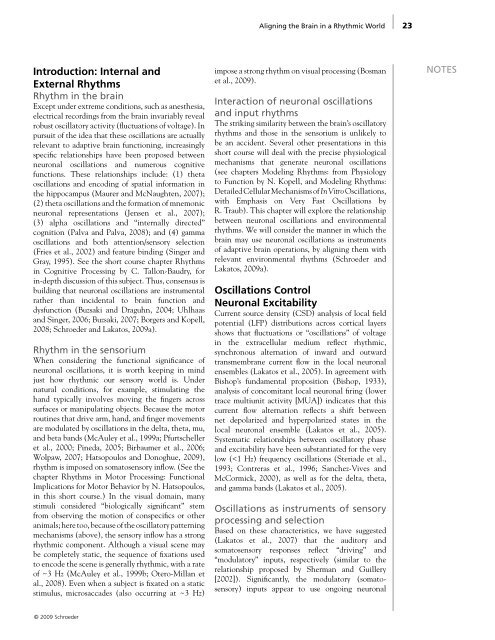Aligning the Brain in a Rhythmic World
Aligning the Brain in a Rhythmic World
Aligning the Brain in a Rhythmic World
Create successful ePaper yourself
Turn your PDF publications into a flip-book with our unique Google optimized e-Paper software.
Introduction: Internal and<br />
External Rhythms<br />
Rhythm <strong>in</strong> <strong>the</strong> bra<strong>in</strong><br />
Except under extreme conditions, such as anes<strong>the</strong>sia,<br />
electrical record<strong>in</strong>gs from <strong>the</strong> bra<strong>in</strong> <strong>in</strong>variably reveal<br />
robust oscillatory activity (fluctuations of voltage). In<br />
pursuit of <strong>the</strong> idea that <strong>the</strong>se oscillations are actually<br />
relevant to adaptive bra<strong>in</strong> function<strong>in</strong>g, <strong>in</strong>creas<strong>in</strong>gly<br />
specific relationships have been proposed between<br />
neuronal oscillations and numerous cognitive<br />
functions. These relationships <strong>in</strong>clude: (1) <strong>the</strong>ta<br />
oscillations and encod<strong>in</strong>g of spatial <strong>in</strong>formation <strong>in</strong><br />
<strong>the</strong> hippocampus (Maurer and McNaughten, 2007);<br />
(2) <strong>the</strong>ta oscillations and <strong>the</strong> formation of mnemonic<br />
neuronal representations (Jensen et al., 2007);<br />
(3) alpha oscillations and “<strong>in</strong>ternally directed”<br />
cognition (Palva and Palva, 2008); and (4) gamma<br />
oscillations and both attention/sensory selection<br />
(Fries et al., 2002) and feature b<strong>in</strong>d<strong>in</strong>g (S<strong>in</strong>ger and<br />
Gray, 1995). See <strong>the</strong> short course chapter Rhythms<br />
<strong>in</strong> Cognitive Process<strong>in</strong>g by C. Tallon-Baudry, for<br />
<strong>in</strong>-depth discussion of this subject. Thus, consensus is<br />
build<strong>in</strong>g that neuronal oscillations are <strong>in</strong>strumental<br />
ra<strong>the</strong>r than <strong>in</strong>cidental to bra<strong>in</strong> function and<br />
dysfunction (Buzsaki and Draguhn, 2004; Uhlhaas<br />
and S<strong>in</strong>ger, 2006; Buzsaki, 2007; Borgers and Kopell,<br />
2008; Schroeder and Lakatos, 2009a).<br />
Rhythm <strong>in</strong> <strong>the</strong> sensorium<br />
When consider<strong>in</strong>g <strong>the</strong> functional significance of<br />
neuronal oscillations, it is worth keep<strong>in</strong>g <strong>in</strong> m<strong>in</strong>d<br />
just how rhythmic our sensory world is. Under<br />
natural conditions, for example, stimulat<strong>in</strong>g <strong>the</strong><br />
hand typically <strong>in</strong>volves mov<strong>in</strong>g <strong>the</strong> f<strong>in</strong>gers across<br />
surfaces or manipulat<strong>in</strong>g objects. Because <strong>the</strong> motor<br />
rout<strong>in</strong>es that drive arm, hand, and f<strong>in</strong>ger movements<br />
are modulated by oscillations <strong>in</strong> <strong>the</strong> delta, <strong>the</strong>ta, mu,<br />
and beta bands (McAuley et al., 1999a; Pfurtscheller<br />
et al., 2000; P<strong>in</strong>eda, 2005; Birbaumer et al., 2006;<br />
Wolpaw, 2007; Hatsopoulos and Donoghue, 2009),<br />
rhythm is imposed on somatosensory <strong>in</strong>flow. (See <strong>the</strong><br />
chapter Rhythms <strong>in</strong> Motor Process<strong>in</strong>g: Functional<br />
Implications for Motor Behavior by N. Hatsopoulos,<br />
<strong>in</strong> this short course.) In <strong>the</strong> visual doma<strong>in</strong>, many<br />
stimuli considered “biologically significant” stem<br />
from observ<strong>in</strong>g <strong>the</strong> motion of conspecifics or o<strong>the</strong>r<br />
animals; here too, because of <strong>the</strong> oscillatory pattern<strong>in</strong>g<br />
mechanisms (above), <strong>the</strong> sensory <strong>in</strong>flow has a strong<br />
rhythmic component. Although a visual scene may<br />
be completely static, <strong>the</strong> sequence of fixations used<br />
to encode <strong>the</strong> scene is generally rhythmic, with a rate<br />
of ~3 Hz (McAuley et al., 1999b; Otero-Millan et<br />
al., 2008). Even when a subject is fixated on a static<br />
stimulus, microsaccades (also occurr<strong>in</strong>g at ~3 Hz)<br />
© 2009 Schroeder<br />
<strong>Align<strong>in</strong>g</strong> <strong>the</strong> <strong>Bra<strong>in</strong></strong> <strong>in</strong> a <strong>Rhythmic</strong> <strong>World</strong><br />
impose a strong rhythm on visual process<strong>in</strong>g (Bosman<br />
et al., 2009).<br />
Interaction of neuronal oscillations<br />
and <strong>in</strong>put rhythms<br />
The strik<strong>in</strong>g similarity between <strong>the</strong> bra<strong>in</strong>’s oscillatory<br />
rhythms and those <strong>in</strong> <strong>the</strong> sensorium is unlikely to<br />
be an accident. Several o<strong>the</strong>r presentations <strong>in</strong> this<br />
short course will deal with <strong>the</strong> precise physiological<br />
mechanisms that generate neuronal oscillations<br />
(see chapters Model<strong>in</strong>g Rhythms: from Physiology<br />
to Function by N. Kopell, and Model<strong>in</strong>g Rhythms:<br />
Detailed Cellular Mechanisms of In Vitro Oscillations,<br />
with Emphasis on Very Fast Oscillations by<br />
R. Traub). This chapter will explore <strong>the</strong> relationship<br />
between neuronal oscillations and environmental<br />
rhythms. We will consider <strong>the</strong> manner <strong>in</strong> which <strong>the</strong><br />
bra<strong>in</strong> may use neuronal oscillations as <strong>in</strong>struments<br />
of adaptive bra<strong>in</strong> operations, by align<strong>in</strong>g <strong>the</strong>m with<br />
relevant environmental rhythms (Schroeder and<br />
Lakatos, 2009a).<br />
Oscillations Control<br />
Neuronal Excitability<br />
Current source density (CSD) analysis of local field<br />
potential (LFP) distributions across cortical layers<br />
shows that fluctuations or “oscillations” of voltage<br />
<strong>in</strong> <strong>the</strong> extracellular medium reflect rhythmic,<br />
synchronous alternation of <strong>in</strong>ward and outward<br />
transmembrane current flow <strong>in</strong> <strong>the</strong> local neuronal<br />
ensembles (Lakatos et al., 2005). In agreement with<br />
Bishop’s fundamental proposition (Bishop, 1933),<br />
analysis of concomitant local neuronal fir<strong>in</strong>g (lower<br />
trace multiunit activity [MUA]) <strong>in</strong>dicates that this<br />
current flow alternation reflects a shift between<br />
net depolarized and hyperpolarized states <strong>in</strong> <strong>the</strong><br />
local neuronal ensemble (Lakatos et al., 2005).<br />
Systematic relationships between oscillatory phase<br />
and excitability have been substantiated for <strong>the</strong> very<br />
low (











![[Authors]. [Abstract Title]. - Society for Neuroscience](https://img.yumpu.com/8550710/1/190x245/authors-abstract-title-society-for-neuroscience.jpg?quality=85)





